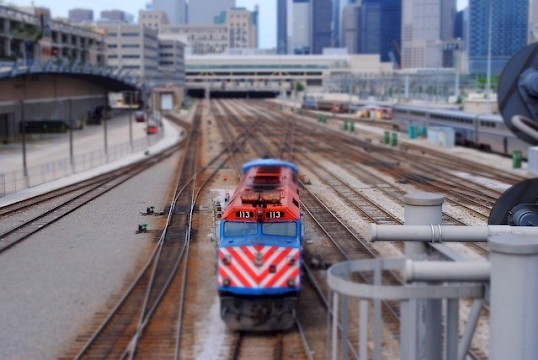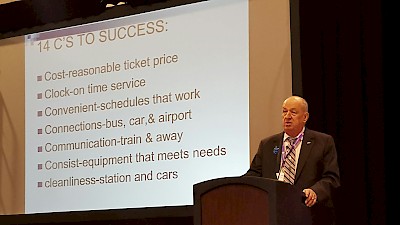Happening Now
Hotline #935
October 30, 2015

The House passed a three-week extension of highway and transit programs that included a three-year extension of the deadline to implement Positive Train Control (PTC). The Senate passed its own bill by voice vote on October 28 extending highway funding through Nov. 20. It has gone to President Obama for his signature.
This marks the 35th short-term extension of surface transportation trust fund over the past six years. Many thanks to the thousands of NARP members who have been waging a campaign to ensure that trains would keep running on January 1, the day after the PTC deadline was scheduled to go into effect. Their efforts helped protect access to the trains tens of millions of passengers rely on every day.
At the same time, a few score of well-paid lobbyists for the freight railroads were working behind the scenes to ensure that their clients could keep shipments moving and, at the same time, delay implementation of this life-saving technology. By November 20, when the three-week transportation extension comes to an end, American passengers will find out to whom Congress was listening.
We urge NARP members to continue contacting your elected officials if you want them to take the next step in creating a safer, more efficient passenger rail network!
The Senate Committee on Commerce, Science, and Transportation approved Sarah Feinberg as Administrator of the Federal Railroad Administration (FRA) by a vote of 19-1. The wide margin of support indicates that Feinberg, currently serving as acting administrator, should have no problem being confirmed by the full Senate.
NARP encouraged Senate Commerce Committee members to confirm the appointment of Feinberg as the new FRA head. “Feinberg has been leading the agency as acting administrator since January, and her performance has earned the respect and thanks of America’s passengers,” wrote NARP President and CEO Jim Mathews. “Stepping into a challenging regulatory and safety oversight environment with minimal background in the rail industry, Feinberg applied her many years of experience as an administrator and a policy advisor to effectively address a series of challenges that have come to the national forefront during her time at the FRA.”
An Amtrak event at the National Press Club on October 26 highlighted the need to make infrastructure planning and investment a national priority. It was hosted by President and CEO Joe Boardman and members of the Chicago Gateway Blue Ribbon Panel. The group discussed the nation’s infrastructure crisis, the growing problem of aging infrastructure and railway congestion, and most importantly, funding.
“Amtrak is doing what it can. But the root of the problem is lack of funding needed to address the congestion challenge that contributes to these delays,” said Boardman. “Persistent underinvestment leads to congestion – and the lack of investment threatens our national economy.” Click here to see a YouTube video on the blue ribbon panel’s recommendations.
According to the New Yorker magazine, meteorologists’ models said New York City and the surrounding coastal region fell directly within the “cone of uncertainty” where Hurricane Joaquin could have made landfall earlier this month. New York Gov. Andrew Cuomo (D) activated the State Emergency Operations Center, while New Jersey Gov. Chris Christie (R) declared a state of emergency. Neither measure was needed, however, since the storm never made it up the East Coast.
Thanks to the devastation caused by Superstorm Sandy in 2012, everyone seems now to plan for extreme weather events more seriously, with special efforts to protect the region’s vital systems for energy, transit, health care and communications, all of which proved so vulnerable to Sandy. Since then, federal and state governments have spent billions of dollars to rebuild critical infrastructure.
The Department of Transportation this week announced it handed out $500 million in TIGER grants for projects in 12 states. One major victory was a $15 million grant to upgrade a New Mexico rail line used primarily by Amtrak’s Southwest Chief, including the replacement of 39 miles of track near Albuquerque, reports the Albuquerque Journal. The funds are part of a larger proposal submitted earlier this year to upgrade tracks in New Mexico, Colorado and Kansas. It included a $1 million contribution from the New Mexico Department of Transportation and $4 million from Amtrak. There were questions about how to pay for track maintenance in New Mexico and two other states, prompting Amtrak officials to propose rerouting the Southwest Chief.
NARP applauds the efforts of ColoRail and its President Jim Souby to save the Southwest Chief’s present route. The Chief serves many smaller communities that have no other intercity passenger transportation options, so the loss of the train’s present route would have been a great loss to them.
An editorial in the Santa Fe New Mexican applauded the state’s congressional delegation -- Democrats and Republicans -- for pulling together to get the $15 million TIGER grant. “This unity proves that our state delegation understands how essential the train service is to the economy of Northern New Mexico. More cooperation, please,” it wrote.
New Jersey won a $16 million grant to fund a project to replace a 105-year-old bridge that is a frequent chokepoint for Northeast rail commuters, reports the Stamford Advocate. New Jersey Transit will spend the money on electrical and fiber optic work, a retaining wall and other projects to enable further construction on the Portal Bridge over the Hackensack River. NJ Transit and Amtrak collaborated to get design and engineering work completed for a new bridge, but about $1 billion is still needed to build it.
And Vermont won a $10 million TIGER grant that will pay to upgrade the last sections of track between Burlington and Rutland, reports WPTZ-TV. Once the upgrades are completed, the Ethan Allen Express passenger train that currently terminates in Rutland will be able to continue north to Burlington within four years. The money will be matched by state funds, and will be used to install welded train track, new sidings, passenger platforms and roughly 13 new crossings.
While Congress allocated $500 million in 2015 for TIGER, the recently passed House surface transportation bill doesn’t authorize the TIGER program. Senate Republicans attempted to eliminate the program in July while drafting the DRIVE Act until a bipartisan group —led by Senators Patty Murray (D-Wash.) and Susan Collins (R-Maine)—were able to strip that language. But with no authorized funding and stagnant levels in infrastructure investments, the TIGER program is on the ropes.
Overall, the highly successful program has invested more than $4.1 billion across six rounds to fund projects that have had significant positive impacts at the national and regional level. But TIGER needs your help, so click here to let your legislators know you want to keep this important grant program going.
During the Fall Meeting, NARP members heard about future plans for the Hoosier State from Ed Ellis, the founder and President of Iowa Pacific Holdings, which took over the Chicago-Indianapolis route from Amtrak. Increasing service from one trip a day for the perennially cash- and passenger-starved Hoosier State line will be a priority for Ellis, reports the Indianapolis Star. He envisions a high-frequency system that runs between Indianapolis and Chicago 14 times a day.

NARP Chairman Robert Stewart speaking at the SmartRail conference.
The SmartRail 2015 Conference, a nation-wide meeting devoted to fostering the development of modern integrated and multimodal transportation systems centered around passenger rail and transit systems, was held in Charlotte, N.C., October 28-29. Among the featured speakers was NARP Chairman Robert Stewart, who presented his vision for creating an attractive service for 21st century passengers. Also in attendance were NARP Vice Chair Chuck Riecks, NARP Director Special Projects and Events Bruce Becker and NARP Member William Bartley. They staffed a booth that provided information about NARP to those in attendance.
The efforts of NARP members to engage with the media on rail issues continued this week. Paul Dyson of Burbank, California, in an LA Times letter to the editor, asks: "Do high-speed rail opponents have an alternative that delivers the capacity of a modern passenger railroad without the pollution and land use? No; in fact, they are noticeably silent when it comes to alternatives."
We thank you, NARP members, for your continued efforts helping to build a 21st century multimodal transportation system. Please continue to let us know what you’re doing by sending along industry-related news stories, op-eds, editorials or letters to the editor to NARP’s communications director ([email protected]). This supports our efforts in Washington, D.C., and we enjoy sharing them with your fellow members. Please continue to pitch blog posts, along with stories and member profiles for the NARP. Finally, follow us on Facebook and Twitter and join the conversation. Have a great weekend!
"It is an honor to be recognized by the Rail Passengers Association for my efforts to strengthen and expand America’s passenger rail. Golden spikes were once used by railroads to mark the completion of important rail projects, so I am truly grateful to receive the Golden Spike Award as a way to mark the end of a career that I’ve spent fighting to invest in our country’s rail system. As Chair of the Transportation and Infrastructure Committee, it has been my priority to bolster funding for Amtrak, increase and expand routes, look to the future by supporting high-speed projects, and improve safety, culminating in $66 billion in new funding in the Bipartisan infrastructure Law."
Representative Peter DeFazio (OR-04)
March 30, 2022, on receiving the Association's Golden Spike Award for his years of dedication and commitment to passenger rail.
Comments